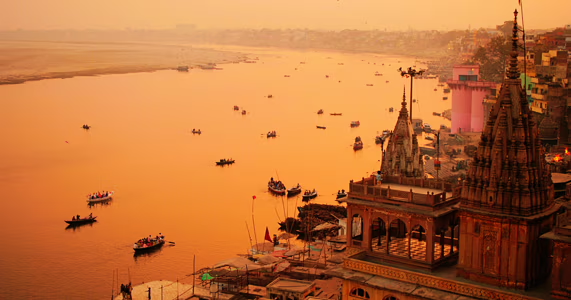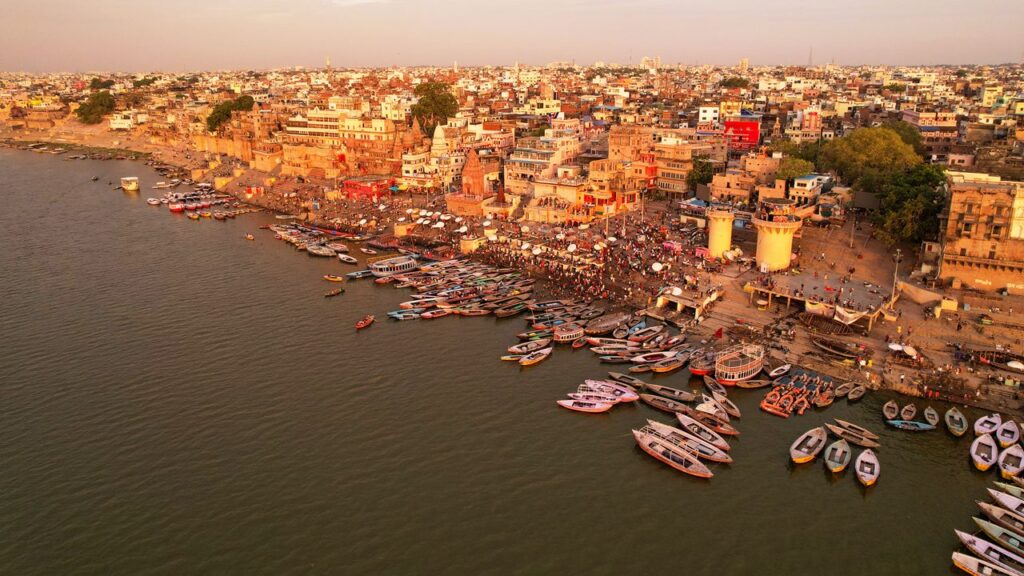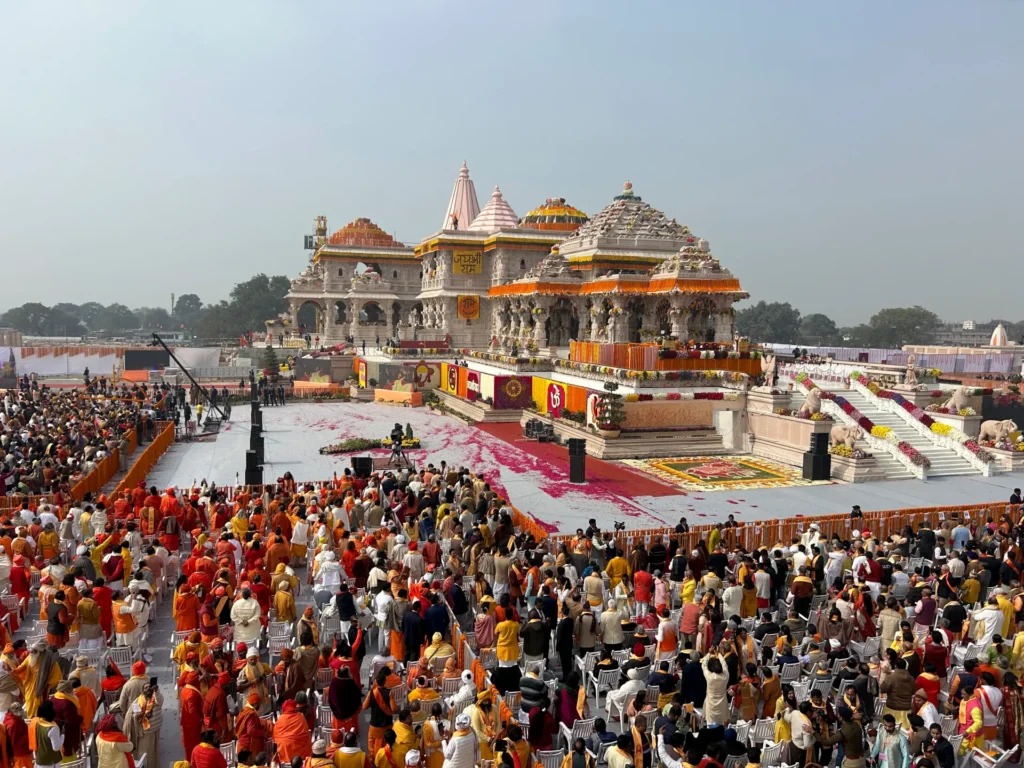Step into the spiritual heart of India with a journey to Varanasi, one of the oldest continuously inhabited cities in the world. Revered as Kashi, the City of Light, Varanasi is a timeless symbol of India’s deep-rooted spiritual traditions, attracting sages, seekers, and pilgrims for thousands of years. Resting along the sacred Ganges River, it is a place where life and death intertwine, and where every breath seems infused with the essence of devotion and liberation.
Often called the spiritual capital of India, Varanasi is more than a city—it is an experience. Here, every ghat, every narrow alley, and every temple whispers ancient chants and sacred stories. The famous Ganga Aarti at Dashashwamedh Ghat, performed each evening with resounding bells and the glow of a hundred lamps, draws devotees and travelers from across the world. It is a ritual that awakens the soul and connects one with the divine rhythm of the universe.
A visit to Varanasi is not just about exploring temples or taking a holy dip in the Ganges—it is about seeking something beyond the physical. From the historic Kashi Vishwanath Temple, one of the twelve Jyotirlingas, to serene boat rides at sunrise that reflect the city’s ageless mystique, every moment in Varanasi offers a chance for introspection and inner peace. It is believed that a death in Kashi leads to moksha—freedom from the cycle of rebirth.



Ayodhya, nestled on the banks of the serene Sarayu River in Uttar Pradesh, is one of the most revered cities in Hinduism. Known as the birthplace of Lord Rama, the seventh avatar of Lord Vishnu, Ayodhya holds a timeless place in the hearts of devotees and seekers of dharma (righteousness). A spiritual epicenter steeped in myth, history, and devotion, Ayodhya offers a deeply moving experience of faith and divine connection.
Whether you’re drawn by the call of ancient temples, the echoes of Ramayana’s glory, or the profound peace that pervades its ghats and shrines, Ayodhya invites every soul into a journey of spiritual rediscovery.
Begin your sacred journey in Ayodhya, where the divine presence of Lord Rama still resonates through the chants, temples, and rituals of the city. The recently consecrated Shri Ram Janmabhoomi Mandir stands as a radiant symbol of devotion, unity, and cultural resurgence. Pilgrims from all over the world visit Ayodhya to offer prayers, seek blessings, and immerse themselves in the timeless narrative of the Ramayana.
From the bustling ghats of the Sarayu River to the tranquil corners of Kanak Bhawan and Hanuman Garhi, Ayodhya offers a blend of spiritual intensity and serene reflection. Each step here feels like a walk through eternity—every corner echoing with stories of divine valor, love, and the triumph of dharma.



Embark on a soul-stirring journey to Prayagraj, an ancient city where spirituality flows as endlessly as the rivers that meet at its heart. Formerly known as Allahabad, Prayagraj is revered as one of the holiest pilgrimage destinations in India, where the sacred confluence (Triveni Sangam) of the Ganga, Yamuna, and the mystical Saraswati rivers offers a divine experience like no other.
A city steeped in mythology and history, Prayagraj is believed to be the king of all pilgrimage sites (Tirthraj). It is here that the Kumbh Mela, the largest spiritual gathering on earth, is held, drawing millions of devotees seeking spiritual elevation and liberation from the cycle of birth and death. The city’s vibrant ghats, ancient temples, and serene ashrams create an atmosphere charged with devotion and timeless wisdom.
Though not traditionally part of the Char Dham route, Prayagraj serves as a powerful spiritual prelude. Many pilgrims visit Prayagraj to bathe in the Triveni Sangam before beginning their journey to the Himalayan shrines, believing the holy dip cleanses one’s soul and opens the path for divine blessings. From here, one carries not only the sanctity of the rivers but also the deep-rooted energy of centuries of penance and prayer.



Tucked away in the heart of Uttar Pradesh, Mirzapur is a land steeped in myth, mysticism, and spiritual allure. Often overshadowed by its more prominent neighbors, Mirzapur holds a quiet power—a timeless aura that attracts seekers, pilgrims, and travelers longing for inner peace and divine connection. With its sacred ghats, ancient temples, and the meandering Ganges flowing in quiet reverence, Mirzapur serves as a tranquil retreat for spiritual awakening and reflection.
Mirzapur is not just a city; it’s an experience—rooted in devotion and wrapped in cultural legacy. It is home to the revered Vindhyachal Temple, dedicated to Goddess Vindhyavasini, a powerful form of Durga, who is believed to reside here eternally after defeating the demon Mahishasura. The temple is a significant Shaktipeeth and draws lakhs of devotees, especially during Navratri, when the entire region vibrates with chants, colors, and deep faith.
Pilgrims often begin their spiritual exploration here by taking a holy dip in the Ganges at the ghats of Mirzapur, seeking purification and blessings before heading into the sanctum of the Vindhyachal hills. Other notable sites like the Ashtabhuja Temple and Kalikoh Temple, tucked amidst the rocky landscapes, add to the divine energy of this region.
Mirzapur’s spiritual essence is not limited to temples. Its landscapes tell stories of sages, saints, and seekers who meditated in its caves and by the riverside. The rhythmic sound of temple bells, the fragrance of incense wafting through ancient alleys, and the serene beauty of the Ganga flowing under the morning sun—Mirzapur creates a perfect environment for self-reflection and divine connection.
Whether you’re a devotee on a pilgrimage, a traveler seeking peace, or a soul yearning for silence, Mirzapur invites you to slow down, listen to the echoes of ancient chants, and immerse yourself in a timeless spiritual experience.




At MmahadevTravels, we believe that every journey should be a memorable experience. Established with a vision to redefine the standards of travel, we offer reliable, comfortable, and affordable travel solutions tailored to meet your unique needs.